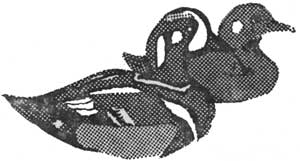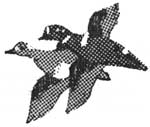YUK IT UP! IT'S THE HARLEQUIN DUCK
Clowns. Fools and jesters. Punch and Judy. Falstaff. Pagliacci.
Petrouschka. Can there be room in that glad company for a duck?

Each of the world's many clowns is unique, with make-up and costume
all his own. And so it is with the Harlequin Duck. If be clown, it is
more in the mold of Emmett Kelly than of Ronald McDonald.
R. T. Peterson calls it "dark and bizarre" and that's true, too. Up
close, the male is splashed in steel blue-grey and rust, with white bars
and streaks in unusual places. At a distance his grey and rust blend to
an unremarkable "dark" but the unique white marks remain. Momma is the
usual ducky blah brown. A white spot and two buffy patches on her head
separate her from all other ducks (including scoters, goldeneyes and
lady buffleheads) at any distance. The white head markings make both
male and female easy to identify; unfortunately, hardly anyone ever
identifies them.
Somehow, gaudy as they appear, clowns blend right into the circus
atmosphere; they become an expected part of the scenery. Perhaps that's
why the showy little ducks get missed. If they associate with others out
at sea they are usually found with scoters and often, therefore, they
are mistaken for scoters. After all, they're dark, aren't they? Scoters,
though, are a third larger (16" plus or minus, in contrast with the
Harlequin Duck's 12 inches) and the white marks, if any, are
different.
The ducks bob offshore during winter in heavy seas--the heavier the
better, it would seem. They ride the dramamine express from central
California north into eastern Asia, though they are rare on the Atlantic
side of the world.
In spring they migrate to their vacation estates. Observers find them
either at sea, or at their summer place; rarely are they ever observed
en route somewhere. Local ducks wend their way to our own plunging,
cascading mountain streams. Others travel to the Arctic Circle to nest.
Some claim that a successful clown must possess a streak of masochism.
Yep.
Here in our mountains the ducks might nest on the ground, or in a
hole in a cliff, cutbank or tree. Momma lays 5 to 10 buffy eggs. Just as
soon as they leave the nest, the fluffy little youngsters take to the
rushing mountain water. They ride the sweeping cascades, get pummelled
against the rocks, flounder and dive in swirling currents. It's
fortunate they bounce.

The ducklings, like their parents, are agile, athletic and inventive,
as a good clown must be. In the mountains they eat insects for the most
part--not so hard to do. But at sea they often dive to great depths for
their primary food, mussels. Imaging trying to break into a mussel using
only a duck bill.
Many of us grew up watching Buffalo Bob try to communicate with
Clarabell's tiny bicycle horn. Clowns are supposed to sound ridiculous;
it's part of the schtick. Whereas ducks are expected to quack or
something, the Harlequin Duck puts forth a most unducky squeak. It used
to be called Squealer or Sea Mouse for that reason. Now and again, it
might laugh at itself with a chortling kwakwakwa.
Carolus Linnaeus named the duck Histrionicus histrionicus
primarily because of its ludicrous paint job--dramatic colouring, if you
will. But histrionics are wild action for dramatic effect. This duck is
rare in Linnaeus's native Sweden. Did he know about its dramatic antics
in howling rivers and crashing seas? There were imitators galore, but no
other clown in history could sweep a spotlight under a rug like Weary
Willie; did Linneaus appreciate our little clown's uniqueness?
Whether Linnaeus ever realized how well he named the duck, you can
appreciate it when you see it in our high country this summer or out on
Puget Sound next fall. The duck won't engender a lot of gags and
pratfalls; it's not a laff-a-minit clown. Rather, it will bring you a
warm, pleasant smile--a happy feeling--like the best clowns do. And if
you would, please stop at a visitor center and record your sighting on a
Wildlife Observation Card. The naturalists are seeking to know more
about this unique little duck, and your observations can help. Besides,
naturalists enjoy sharing your pleasure--they love clowns, too.
Sandy Dengler
WILDLIFE OBSERVATIONS
Wildlife sightings have been a bit slow this winter, but a few
critters have been reported. With spring's arrival, a pair of mallard
ducks stopped off at the beaver ponds in Longmire Meadow. A pair of
Barrows goldeneye have been seen swimming in the pond at the Stevens
Canyon Entrance. A pied-billed grebe mistook the rain-wet road in the
Ohanapecosh housing area for a watery landing strip. It crashed, but was
rescued by Ohanapecosh residents and helped on its way. A hairy
woodpecker was sighted looking for lunch in a Douglas fir snag on the
Trail of the Shadows, and a sawwhet owl was heard near the tennis court
at Tahoma Woods.
The predators are moving around too. Coyotes have been seen near the
"goat overlook" below Longmire, along the Stevens Canyon Road, and at
Box Canyon. A bobcat was observed near the treatment plant at
Ohanapecosh, and a mountain lion was reported crossing the road west of
Kautz Creek.
Goats made up the largest number of observations. Thirty-nine animals
were recorded. Twenty-two were seen at Tum Tum. The largest group there
was thirteen goats; twelve adults and one kid.
This appears to be an unusually large group for Tum Tum. Five goats
were reported from Mt. Wow. Five were seen above the Stevens Canyon
Entrance, and seven between Box Canyon picnic area and the upper tunnel
on the Stevens Canyon Road.
As the snow melts, animals may be more active. Bears, for one, should
be beginning to move around. No bear observations have been received yet
this spring. Are they all gone? Hungry bears sometimes peel bark from
trees. This may be in the tops, like porcupine, but bigger bites, or on
the base of the tree. Fresh, white, peeled trees at this time of year
probably is an indication of bear activity. We would appreciate bear
observation reports, especially early in the year, to document when they
emerge from hibernation.
Stan Schlegel

